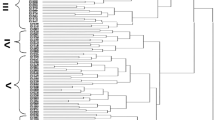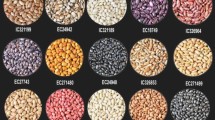Summary
A landrace seed lot of runner bean (Phaseolus coccineus L.), obtained from the Budapest region, Hungary, was separated into five seed groups according to seed coat colour. 131 plants were grown randomly, and observed for 27 morphological and physiological characters. The collected data were analysed by ANOVA.
Numerical taxonomy of the data employed Principal Components Analysis to generate scatter diagrams and Cluster Analysis to generate dendrograms, both before and after removing data on the four anthocyanin colour characters (seed coat, calyx, stem and flower colour) as these characters are probably controlled by a single major gene. The progenies from the five distinct parental seed groups showed much overlap in characteristics, indicating that they were not distinct lines but comprised a largely panmictic population.
Some character associations were detected: plants from white seeds matured significantly later than those from black seeds, plants from white seeds with a few dark spots produced seeds significantly heavier than average, whereas those from white or black seeds produced significantly lighter seeds, although the average seed yield per plant did not differ significatly.
Similar content being viewed by others
References
Arias, L.M., 1980. Relación entre agrohabitats y variantes del complejo Phaseolus coccineus L. en le Mesa Central de Chiapas, Mexico. Tesis profesional. U.A.E.M., Mexico. Cited by Salinas (1988).
Bassett M.J., Xue L.-B. & L.Curtis Hannah, 1992. Flower colors in common bean produced by interactions of the Sal and V loci and a gametophyte factor a linked to Sal. J. Amer. Soc. Hort. Sci. 1156: 1029–1033.
Beridze R.K., P.Hanelt & J.Kruse, 1982. Report on a travel to the Georgian SSR 1981 for the collection of indigenous material of cultivated plants. Kulturpflanze 30: 203–213.
Blackwell F.L.C., 1971. Pod-seeding and yield in the runner bean (Phaseolus coccineus L.). Bull. Nat. Inst. Agric. Bot. 12: 45–56.
Brok H., 1991. Enkele bloemnamen in de Nederlandse dialekten. Publikatie no 18 van het P.J. Meertens-Instituut, Amsterdam. 372p.
Burquez, A., 1979. Biologío floral de poblaciones silvestres y cultivadas de Phaseolus coccineus L. Tesis profesional de Biólogo. Fac. de Ciencias, U.N.A.M., Mexico. Cited by Salinas, 1988.
Campion B. & E.Servetti, 1991. Breeding in the runner bean (Phaseolus coccineus L.) for the development of dwarflines. J. Genet. & Breed. 45: 173–180.
Hammer K., S.Cifarelli & P.Perrino, 1986. Collection of landraces of cultivated plants in South Italy, 1985. Kulturpflanze 34: 261–273.
Hammer K. & P.Hanelt, 1979. Botanische Ergebnisse einer Reise in die VR Polen, 1976 zur Sammlung autochthoner Landsorten von Kulturpflanzen. Kulturpflanze 27: 109–149.
Hanelt P., K.Hammer, J.Schultze-Motel & W.Kulpa, 1982. Katalog der 1978 in der VR Polen gesammlten indigenen Kulturpflanzen-Sippen. Kulturpflanze 30: 215–244.
IBPGR, 1983. Phaseolus coccineus descriptors. AGPG: IBPGR/82/74, Intern. Board Plant Genetic Resources secretariat. Typescript. Rome. 34p.
Kooiman H.N., 1931. Monograph on the genetics of Phaseolus. Bibliographica Genetica 8: 295–413.
Koster H., 1986. Classification and identity research of varieties of Phaseolus beans in the Netherlands. Acta Hortic. 182: 402–406.
Kühn F., K.Hammer & P.Hanelt, 1973. Botanische Ergebnisse einer Reise in die CSSR 1977 zur Sammlung autochthoner Landsorten von Kultupflanzen. Kulturpflanze 28: 183–226.
Kühn F., H.Ohle & K.Pistrick, 1984. Katalog der 1981 in der CSSR gesammelten indigenen Kulturpflanzen-Sippen. Kulturpflanze 32: 153–196.
Lamprecht H., 1948. On the effect and linkage of genes transmitted from Phaseolus coccineus to Ph. vulgaris. Agrar. Hort. Genet. 6: 64–81.
Mallekote, L., 1952. Zaadteelt. Purmerend. 224p.
Mota M., R.Farias, M.Teixeira & E.Bettencourt, 1982. Zea & Phaseolus collecting in Portugal. FAO/IBPGR Plant Genetic Resources Newsl. nr 50: 20–21.
Muruaga, F.S. & F. Cardenas Ramos, 1991. Phaseolus coccineus hybridization and pollination (90/74). Evaluation of natural hybridization and pollination in Phaseolus coccineus. Progress Reports FAO/IBPGR Plant Genetic Resources Memo no 86: 47.
Oldham, C.H., 1950. Vegetable growers guide. Reading. 172p.
Olthoff, B.H. & F. Mulder, 1953. Handleiding voor de zaadteelt op landbouwbedrijven. 's-Gravenhage. 211p.
Perrino P. & K.Hammer, 1985. Collection of landraces of cultivated plants in South Italy, 1984. Kulturpflanze 33: 225–236.
Perrino O., K.Hammer & P.Hanelt, 1981. Report of travels to South Italy 1980 for the collection of indigenous material of cultivated plants. Kulturpflanze 29S: 433–442.
Perrino P., K.Hammer & P.Hanelt, 1984. Collection of landraces of cultivated plants in South Italy, 1983. Kulturpflanze 32: 207–216.
Purseglove, J.W., 1968. Tropical crops. Dicotyledons 1. Longmans. 332p.
Quagliotti, L., G. Lepori & A. Baldi, 1980. In: P.D. Hebblethwaite (Ed.). p. 569–581. Seed production. Butterworth. 694p.
Quagliotti L. & F.Marletto, 1987. Research on the pollination of runner bean (Phaseolus coccineus L.) for dry grain production. Adv. Hortic. Sci. 1: 43–49.
Reyes J.J.E. & J.Kohashi, 1978. Efecto de la densidad de problación en el rendimiento y sus componentes en un frijol de guiáy ‘ayocote’ (Phaseolus coccineus L.) cultivados con espaldara. In: Avances en La Enseñanza en Investigación 1977–1978. Colegio de Postgraduados, Chapingo, Mexico. Cited by Salinas, 1988.
Ron A.M.de, R.Lindner, R.A.Malvar, A.Ordás, J.J.Baladrón & J.Gil, 1991. Germplasm collecting and characterization in the north of the Iberian Peninsula. FAO/IBPGR Plant Genetic Resources Newsl. 87: 17–19.
Salinas A. Delgado, 1988. Variation, taxonomy, domestication and germplasm, potentialities in Phaseolus coccineus, p. 441–463. In: P.Gepts (Ed.). Genetic resources of Phaseolus beans. Kluwer Academic Publishers, Dordrecht. 613p.
Segal, S., 1991. Jan Davidsz de Heem en zijn kring. Den Haag. 148p.
SPSS-X., 1988. User's Guide. 3rd. edition. Chicago. 1072p.
Tjebbes K., 1925. Die Zeichnung der Samenschale von Phaseolus multiflorus. Hereditas 7: 129–144.
UPOV, 1982. Union pour la Protection des Obtentions Végétales, Geneva. TG/12/4 French bean/Haricot/Bohne, 82–11–19: 7–14.
Vanderborght T., 1983. Increasing seed of Phaseolus coccineus L. FAO/IBPGR Plant Genetic Resources Newls. nr 53: 17–18.
Wall J.R., 1970. Experimental introgression in the genus Phaseolus. I. Effect of mating systems on interspecific gene flow. Evolution 24: 356–366.
Westphal, E., 1974. Pulses in Ethiopia, their taxonomy and agricultural significance. Wageningen. 261p.
Wyatt J.E., 1977. Seed coat and water absorption properties of seed of near-isogenic snap bean lines differing in seed coat color. J. Amer. Soc. Hortic. Sci. 102: 478–480.
Wijnands, D.O., 1992. In het spoor van Columbus, Amerikaanse planten in Nederlandse stillevens. In preparation.
Zeven A.C., 1992. Variation observed among bread wheat plants found in durum fields on Rhodes in 1987. Genetic Resources and Crop Evolution 39: 3–7.
Zeven A.C. & J.Waninge, 1989. The presence of three groups of Scalavatis and other hexaploid bread wheat plants contaminating durum wheat fields in Cyprus. Euphytica 43: 117–124.
Author information
Authors and Affiliations
Rights and permissions
About this article
Cite this article
Zeven, A.C., Mohamed, H.H., Waninge, J. et al. Phenotypic variation within a Hungarian landrace of runner bean (Phaseolus coccineus L.). Euphytica 68, 155–166 (1993). https://doi.org/10.1007/BF00024164
Received:
Accepted:
Issue Date:
DOI: https://doi.org/10.1007/BF00024164




